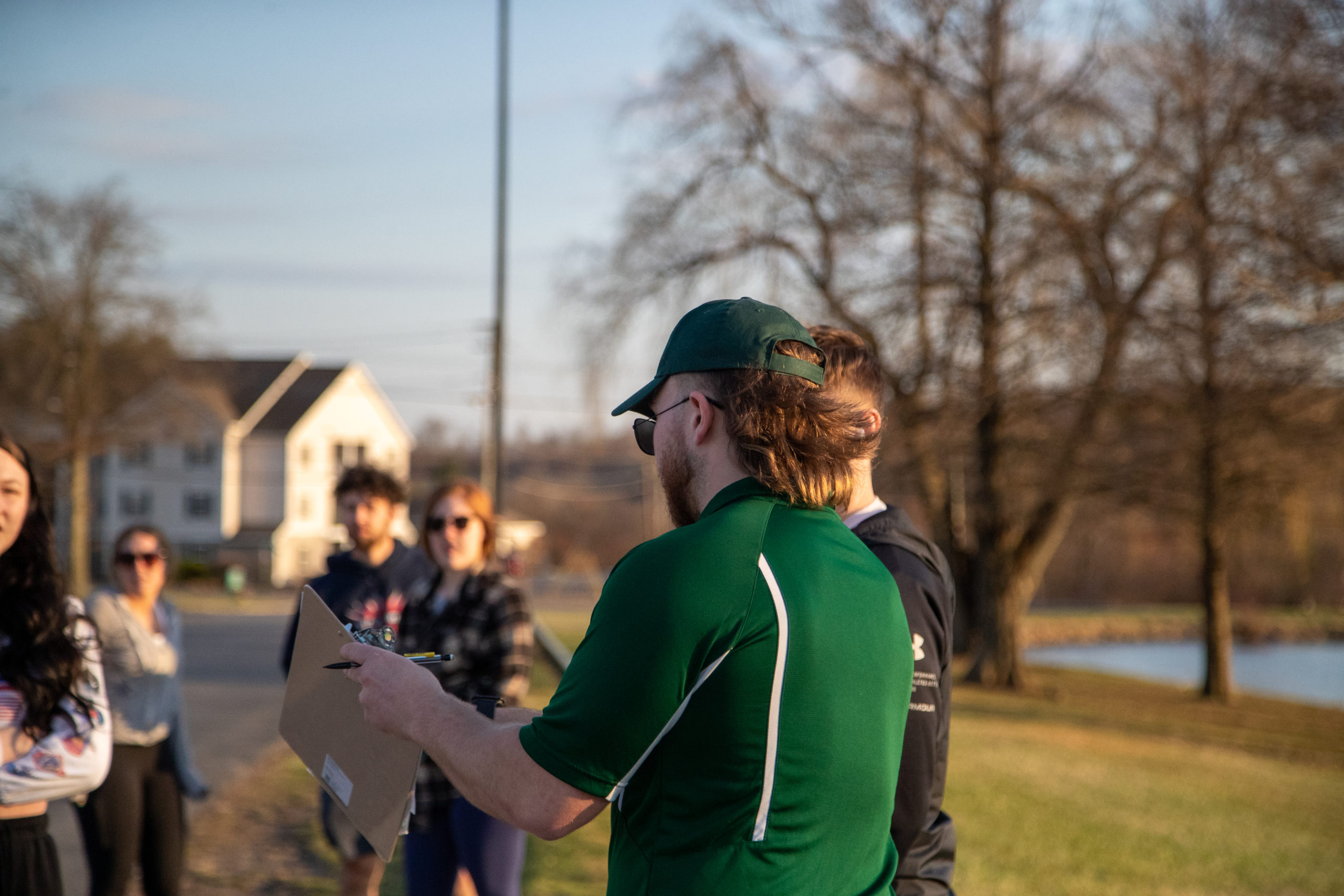We can crawl if we want to
The Slippery Rock Student Government Association (SRSGA) kicked off its campus safety week on Monday evening with its annual Campus Safety Crawl.
The event, led by Vice President of Student and Academic Affairs Grant Warmbein saw the SRSGA and American Society of Safety Professionals (ASSP) team up with students to identify possible safety issues on the university’s 660-acre campus.
More than 20 participants took part in the event, a slight increase from the previous year.
To kick off the event, Warmbein briefed the students on what sort of hazards to look out for, breaking the group into small teams armed with clipboards and maps. The groups then scattered across campus to inspect their assigned areas for hazards.
Samuel Miloser, a junior safety management major and president of the ASSP chapter at Slippery Rock University, led his group from the Robert M. Smith Student Center (SSC) down to the East Lake Lot. The students, who don’t spend as much time on that side of campus, took a minute to figure out which parking lot and roadway they needed to check, but were soon off. Almost immediately they found an issue.
Cracks and uneven pavement, which could present a trip hazard to students making the long trek from the parking lot to the Quad, were spotted only a few feet away from the group’s starting position.
This is the first time Miloser is participating in the Campus Safety Crawl, something he would like to see more safety management majors get involved with as the event continues.
“We are here as a resource [to the campus], not just as safety management majors,” Miloser said.
In the past, members of the ASSP and safety management majors have taken an active role in the Campus Safety Crawl because they were also members of the SRSGA. Former Vice President of Student and Academic Affairs Leif Lindgren who studied safety management, was able to lead the event last spring while the campus still dealt with the COVID-19 pandemic.
Continuing down Stadium Drive to East Lake Lot, the group took note of a drainage grate that sitting below the pavement. A few members of the group remarked how the issue could easily cause damage to their vehicle while driving over it.
While their classes might not take them to this side of campus often, Synclaire Angelow found the hunt for safety issues fun and something that will benefit her in the near future while on walks with her East Highland white terrier, Archie.
“He loves to come out here and chase the geese,” Angelow said.
Both Angelow and her friend Kasey McClain are junior exercise science majors but that doesn’t mean having a safe campus to enjoy is any less important to them.
“This is our campus too,” McClain said. “Just because we are not [safety management majors] doesn’t mean we shouldn’t care what our campus looks like or the safety measures [put in place].”
While not something many outside the safety field would notice, Miloser took time to explain the importance of proper drainage around retaining walls to prevent costly erosion. Miloser showed how rainwater flowing down to the lake has created a widening gap and sharp drop off between the retaining wall and the metal guard rail.
“As house owners, as we’re all going to be in the next 10 years, unfortunately,” Miloser said. “Putting a French drain, the water will run through the rocks and not erode the soil.”
SRU’s campus includes an 18-hole disc golf course that spans across the campus including around East Lake Lot. For Lucas Saunders, a senior business management major and disc golf player, hole two on the course can be a possible safety problem.
“Half the time when people are playing disc golf, they end up on the East Lake Road,” Saunders said. “Some people I know have hit cars in the past.”
Saunders picked up disc golf during the pandemic when he and his friends couldn’t compete in ultimate freebie games.
“It’s something nice to do to get out of the house,” Saunders said. “It’s our little COVID-19 hobby.”
Saunders doesn’t want to see the course get smaller or removed but believes by changing the starting position for hole two, players and passersby can be safer.
The biggest concern the group found with East Lake Lot was the abrupt end of the sidewalk with four more rows of parking to walk down toward. They also pointed out a vehicle that appeared to be involved in a collision that has been parked in the lot for some time.
After about an hour combing through the campus, the group met back up at the SSC to talk about their findings and give them to members of SRU’s facilities department.
Scott Albert, associate vice president of facilities, environmental safety and sustainability, said the group turned in more than 100 concerns ranging from safety lighting to crosswalks. Issues with sidewalks around campus made up more than a third of the concerns brought forth by the students.
Albert said the event allows students to give back to the campus and have a better understanding of how maintenance operates.
The Campus Safety Crawl also allows students to not only be an extra set of eyes for maintenance, but provide input from a unique perspective.
“An out of the way place with no lighting will look different to a 50-year-old male versus an 18- or 19-year-old young woman,” Albert said.
In the past, feedback from the Campus Safety Crawl has given facilities the information they need to provide better lighting around campus. As for the concerns brought forth this week, many will have work orders in place by the end of the week, Albert said.
Albert, who walked around the football stadium and Building F with students and staff from facilities, said they found animals digging around the building that will need to be filled in and a rusting metal door that will have to be replaced.
With spring officially here, many potholes were noticed throughout campus as well and facilities will have to prioritize their repair as the department has only allocated $250,000 for asphalt repair.
Warmbein said the Campus Safety Crawl was big success and a great way to kick off-campus safety week. Throughout the week, organizations hosted events from drowning prevention to pepper spray training. Warmbein said it was his staff’s creativity that allowed for the week to have something for everyone.
Looking toward the future, Warbein said he would like to continue the partnership with the ASSP and would suggest to his replacement moving the event back to the fall semester, allowing for better weather. Before, the event was typically held around October or November.
More information about campus safety week can be found on the CORE events page.






